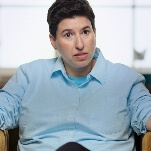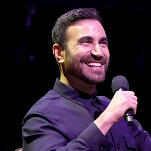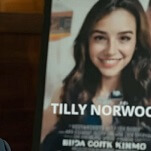This October, like so many Octobers before it, has seen the release of new horror movies, presumably with the aim of capturing the attention of a pre-Halloween crowd in addition to the usual genre diehards. The Conjuring spin-off Annabelle debuted to bigger-than-expected numbers at the beginning of the month, as did Dracula Untold the following weekend, and the Michael Bay-produced Ouija made a quick buck the weekend before Halloween, raking in nearly $20 million. Standard operating procedure.
It’s surprising, though, how half-assed this programming feels. While there was a time in the mid-2000s when October might feature as many as three or four wide-release horror movies, this year’s crop appears to have fallen onto the calendar almost accidentally, when Paramount decided not to put out Paranormal Activity 5 in October. Despite being a prequel to one of the biggest horror movies ever, Annabelle was a relatively late addition to the release schedule; like a lot of the Paranormal sequels, it didn’t even get a trailer until six or seven weeks before it was scheduled to debut. Similarly, Ouija looks like a Paramount stopgap, while Dracula Untold plays more like medieval fantasy than Halloween-ready horror. As popular as horror has been over the past decade-plus, many Octobers have been more or less ceded to a Saw or Paranormal Activity franchise entry, released in October less in deference to fall spookiness than the financial tradition of a horror movie opening surprisingly huge. Last year, the biggest horror sequel of the year, Insidious Chapter 2, semi-inexplicably opened in September, leaving October wide open. This fall, Kevin Smith’s Tusk also scored a late-September release, even though its weird mash-up of midnight movie and stoned campfire tale would be a natural fit for October.
It might seem churlish to complain that October is lacking in brand-name horror when there’s a more noticeable problem: Often, all months of the year are lacking in quality brand-name horror. This October and in general, the most interesting horror movies are available either in very limited theatrical release or, for the majority of viewers, through a VOD service. Horror fans getting their fix at home is preferable to years past, when horror movies as distinctive as May or Ginger Snaps were relegated to cursory, wandering theatrical releases seemingly constructed only to keep them from direct-to-DVD status. (Ginger Snaps basically was a direct-to-DVD title in the U.S., though it did receive a proper release in its native Canada).
Despite these advances, there’s also something small and sad about relegating any horror movie not involving found footage exorcisms or James Wan-approved ghosts to home screens. This applies not just to horror auteurs like Ti West, but also novices like Smith, because horror movies are—for better and worse—perhaps the purest distillation of the filmgoing experience at large. Most movies play better theatrically than at home, but this is particularly true of the horror genre, with its special ability to feed off of the sometimes-unnatural alchemy of sitting in the dark in a public place with a bunch of strangers. For example: I’m not sure I could go to bat for the virtues of the Scream sequels as movies—but part of the reason I’m not sure is that they’re so inextricably linked to my experiences watching them in the theaters, with giant crowds laughing and screaming along as Wes Craven played them like fiddles, then joked about playing them like fiddles. Well-executed suspense, fun performances, and clever dialogue can all flourish anywhere. But a major reason movies are sometimes more than the sum of their raw elements is the unique captivation of the theatrical experience.
Home-viewing partisans often cite rude crowd behavior—the non-curated company of other humans—as a reason to stay home and rock the VOD. As someone who absolutely despises texting, chattering audiences, and who gladly sold out his younger self by telling a group of teenagers to please be quiet during a showing of Wreck-It Ralph, I sympathize with this line of thinking. Horror movie audiences have a reputation as particularly noisy and restless, because horror movies tend to attract teenagers, who non-teenagers unanimously cite as the worst demographic in the world.
Living in New York, I have witnessed firsthand the way horror movies draw out young crowds with great urgency on opening weekend, only to have portions of those crowds talk, text, and (I assume) Snapchat through half the movie. Even more puzzling, I’ve noticed that—in New York at least—even horror movies that seem to hold their audiences relatively rapt often face virulent boos as the credits roll. I understood it when it happened to, say, The Devil Inside. That movie’s check-out-our-website credits tag was clearly intended as a final beyond-the-movie chill, and it was treated, correctly, as a crass marketing device masquerading as a non-ending to a narrative. I wanted to boo myself. But by its January 2012 release, I had experienced such audience hostility to so many okay-to-decent horror pictures that, if anything, booing seemed too typical, too easy. Anyone who boos at the likes of Paranormal Activity 3 really ought to burn the theater down after The Devil Inside.
Indeed, booing often accompanies movies that end with nothing more offensive than genre conventions (in found-footage, the cameraman being attacked/killed, and the screen going black; in slasher movies, the implication that the murderer has survived; and so on). Given the wealth of tropes and clichés in horror movies in general, this seems akin to angry boos greeting a romantic comedy that ends in a wedding. It’s hard to say for sure, but I wonder if the occasional big-twist movies like The Sixth Sense or, less reputably, Saw have created the expectation of a final, left-field, vaguely insane twist that audiences wish were grafted onto any and every horror experience. Even so, frustration with clichés, however understandable, runs counter to everything an even mildly film-savvy audience should expect from a particular genre.
Yet horror’s rep as one of the lowest and basest of genres somehow hasn’t dissuaded a portion of its audience from approaching each entry with crazy high expectations—and in its way, this baffling phenomenon has its place. Going out to a movie, especially a movie that can be watched at home for cheaper and/or will be available to stream or buy within three or four months at the outside, is an absurd act of faith. In bigger cities, with ever-rising prices, 3-D, and “premium” experiences, we’re gambling as much as $15 to $20 on the sometimes dubious proposition that a movie will provide sufficient entertainment or even some kind of emotional or intellectual reaction for upward of 90 minutes. The horror audiences that come out for the opening night of every stupid exorcism retread or haunted-house regurgitation are making that same gamble in the pursuit of thrills and/or chills. They deserve the chance to experience (and lob ungrateful boos at) better, weirder, more thrilling movies.
As do most moviegoers, of course—and like the horror audience, a lot of people will always react with disappointment or irritation when faced with challenging and insulting movies alike. But it makes sense that horror would prompt more vocal, immediate reactions; few cinematic experiences have such a potent combination of the visceral and the vaguely cheap. There’s a dark attraction to the idea of seeing something truly (or even somewhat) frightening, twisted, or unsettling out in public, with a crowd that can’t be controlled. Big-budget action-adventure or fantasy movies are frequently compared to rollercoasters, but horror movies tend to be more aesthetically similar, summoning elemental cocktails of dread and excitement, usually temporary. (Although the best of them, like The Blair Witch Project, A Nightmare On Elm Street, or Halloween, can linger, chilling as much as thrilling).
You can reproduce this feeling at home: Turn down the lights, invite friends over, surround yourselves with Halloween candy, whatever it takes, while eliminating those pesky strangers you can’t control. The thing is, home viewing doesn’t actually eliminate bad viewing behavior. If anything, it’s a safe and acceptable haven for pausing, texting, talking, second-screening, or curling up and falling asleep. All of these activities can be enjoyable, and better enjoyed at home than at a theater, where they could ruin a movie for other viewers. But they aren’t the same experience as venturing out of your home, into the dark. This experience doesn’t have to be unique or exclusive to October, but it’s certainly the right season for it. Going out to horror movies is essentially an aged-up equivalent of trick or treating. Sometimes you get a Nightmare On Elm Street treat; sometimes you get a Devil Inside trick. Some movies offer both mixed together.
Of course, a theatrical release wouldn’t much improve the quality of an indie-horror picture that doesn’t quite work, like this month’s Horns, or any number of lower-rent items that appear on VOD throughout the year—or, for that matter, any number of low-rent horror movies that do turn up in theaters. But more horror movies deserve that shot, both from their studios and their potential audiences: that best attempt to startle or haunt people out in public, or even to leave them booing as they storm out into the night.







































